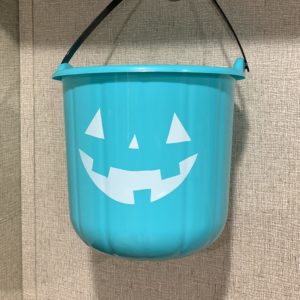
For those of us who stay in all-ages RV parks, we sometimes get to give treats to trick-or-treaters! Because Jen has celiac disease and a long list of allergies, and we’re vegan for ethical and health reasons, we put a lot of thought into our Halloween treats.
We highly recommend giving away non-food treats, like pencils, puzzles, bubbles, glow sticks, and LED light-up toys. These can be purchased for about the same price (or less!) than most candy, and can be enjoyed by even more kids.
The Teal Pumpkin Project started a few years ago as a way to raise awareness about food allergies, and a way for families with allergies to identify themselves and others as “safe” homes for trick-or-treating.

Who benefits from non-food treats?
Kids with food allergies
The 8 allergens considered to be the most common in the U.S. are milk, eggs, fish, crustacean shellfish, tree nuts (e.g., almonds, walnuts, pecans), peanuts, wheat, and soy beans. However, kids can be allergic to just about any food, and some more common allergies are even harder to avoid. These include corn (including corn syrup, which is in most U.S. candies), seeds (such as sesame or sunflower), certain meats, certain food colorings, and certain fruits and vegetables.
The word “allergy” has come to encompass many symptoms. While the traditional definition is to mean anaphylaxis, a life-threatening reaction when exposed to allergens, allergic reactions can worsen over time (where a mild rash may turn into a life-threatening blocked airway), and appear suddenly after being exposed to previously-safe foods. Other allergic reactions include severe nausea, vomiting, or diarrhea (which can have long-term problems such as dehydration), or more difficult to identify reactions such as difficult concentrating, migraines, and muscle or stomach pain. Kids with even mild allergies need to be cautious that their allergies don’t worsen over time. (It’s a myth that all children outgrow allergies.)
There is also a phenomenon known as cross-reactivity, which means people with certain allergies to foods or environmental allergens can react to other seemingly unrelated foods due to similar proteins in each. For example, people with latex allergies sometimes need to avoid things like banana, kiwi, and/or avocados, and people with allergies to birch pollen may need to avoid foods like apples, walnuts, or tomatoes.
Kids with celiac disease
Celiac disease is not an allergy, but an autoimmune disease where the body’s immune system attacks healthy cells (usually in the intestines) when exposed to gluten, a protein found in wheat, barley, rye, and grains related to these species.
Untreated celiac disease can result in anemia, nutritional deficiencies, learning difficulties, and cancer, along with dozens of other debilitating symptoms.
Unfortunately, just sticking to foods labeled “gluten-free” is not enough for many people with celiac disease. They (We!) need to avoid foods that many be contaminated with gluten, such as those made on shared equipment or in shared facilities as gluten-containing products.
Many kids with celiac disease also have food allergies, as well.
Kids with diabetes
Diabetes (type 1 or type 2) is an illness that affects the body’s ability to metabolize sugar, and when it’s not properly managed, it can result in blindness, amputations, organ failure, or death. For kids with diabetes, this time of the year can be especially frustrating, while their friends and siblings are enjoying sugary treats without a second thought. While sugar-free candy is an option, it tends to be very expensive, and sugar-free does not mean carbohydrate-free, and is not always safe for all kids with diabetes.
Kids with feeding tubes
There are many reasons kids may have feeding tubes to supply their nutrition, and many of those reasons are not visible to strangers. Some kids with tubes do eat food by mouth, but for those who don’t or can’t, why not help them fully participate in the Halloween festivities?
Kids with other medical or dietary needs
There are a million reasons why kids may not be able to indulge in candy this Halloween, and we don’t need to list all of those reasons here. Those reasons aren’t even our business!
The good news is that there’s an easy way to include all trick-or-treaters in your Halloween festivities.
Where can I buy non-food treats?
- Search Target’s Teal Pumpkin Project for awesome decorations, and treats like pencils, bubbles, rings, glow sticks, cat ears, and bouncy balls
- Search Amazon’s Halloween Party Favors for stuff like these dinosaur figures and LED light-up rings (get 100 of either for $15!).
- Dollar stores! There are tons of awesome little non-food treats at dollar stores.
Can I still give out candy?
Sure! We suggest having a bowl of candy and a bowl of non-food treats, and letting kids pick for themselves. You can even print out Food Allergy Research and Education (FARE)’s “Candy or Prize?” sign (PDF)
If you’re looking for allergy-friendly candy, we especially love Dum Dums lollipops around here, because they’re free of the top 8 allergens, are small, and tend to be safe for many kids. (And as a bonus, they tend to be very affordable to buy in bulk!)
Where can I learn more?
- Food Allergy Research and Education (FARE)’s list of ideas for non-food Halloween treats.
- FARE‘s website is a wealth of information about life with food allergies.
- Beyond Celiac’s article about celiac disease and children.
- Do It Yourself RV has a cool post about 10 campgrounds that love to celebrate Halloween.
- Always on Liberty has a great post about Halloween decoration ideas for your RV.